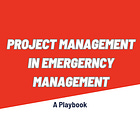Project Beginnings + Hacked Utilities + Covid's impact in charts & Much More
Profiles in Preparedness #21
Recognizing a gap in your organization’s readiness is only the first step to getting left of bang. What happens next is what truly matters.
Once you’ve identified an area that needs improvement, the real challenge begins: turning that awareness into action. And the biggest indicator of whether your project will succeed? How you start.
A strong kickoff lays the foundation for clear direction, stakeholder alignment, and, ultimately, a successful outcome.
I break down why the way you begin a project can determine its success before the real work even starts in the article below.
This Week‘s Reads
Here are a few standout reads from this week with insights, ideas, and perspectives that caught my attention.
Article | Volt Typhoon hackers were in Massachusetts utility’s systems for 10 months. This article highlights a report from OT cybersecurity company Dragos about their work supporting Littleton Electric Light & Water Department's response to China’s Volt Typhoon hackers. This is another unsettling reminder of how vulnerable our critical infrastructure is to cyber threats and China’s work to prepare for conflict with the U.S. This isn’t just a cybersecurity issue; it’s a public safety concern. It doesn’t matter if the lights go out because of a cyber attack or a public safety power shutoff because of weather, government leaders need to be ready to manage an extended duration outage in their communities.
Article | Companies Build "Capabilities" Before They Build "Moats." In emergency management, capability building (the assessments, planning, and exercises to prepare for future disasters) is a core part of our job. But this article highlights how business leaders and investors use the same concept, ensuring the companies they back are putting in the work to develop core competencies before trying to build competitive advantages. The key takeaway isn’t about what investors look for, but how the same disciplined approach to building capabilities can be applied across an organization. If we want leadership buy-in, this is one more way to speak their language, because capability building isn’t just an emergency management need; it’s critical to business success.
Report | Direct Exposure to Mass Shootings Among US Adults. A survey of 10,000 U.S. adults found that 7%—or 1 in 15—reported being present at a mass shooting (defined as an incident where four or more people were shot). That’s not just a series of isolated incidents, but something that has become a persistent reality in our communities. While data collection has limitations and personal perspectives shape how people interpret these findings, every report like this adds to the broader effort to quantify and contextualize the risks of mass violence and drive people to act. For those working to prevent violence, this report underscores the urgency of moving left of bang, whether that’s through interdicting attackers before they act or addressing the deeper conditions that lead individuals toward violence.
Book | This is Strategy by Seth Godin. Had some driving time this week and listened to Seth Godin’s This is Strategy. I have to say, it’s unlike many other books on strategy I’ve come across. The format alone makes it stand out, as it is a series of almost 300 short chapters/reflections. I won’t say this book will resonate with everyone, but I found it thought-provoking in a way that forced me to reconsider some long-held ideas. If you’re in a role where decision-making, planning, or leadership intersect, this might be worth a listen—if only to shake up how you think about strategy in your own work.
Post | Asserting Your Readiness. Here are a couple of quotes to get your attention: “‘Ready’ means ‘fully prepared.’ We should never assert that we are ‘ready’ for something as powerful as wildfire, and pretending that we are induces complacency.” “The truth of readiness is determined in the aftermath of an event.” “This is not a time to project confidence. It’s a time to acknowledge our unpreparedness and do something about it.” This is something for agency leaders and PIOs to consider. Do you attempt to convey extreme confidence, or do you call out the gaps and lead the way to actively closing them?
Article | 30 Charts That Show How Covid Changed Everything. Five years after the initial Covid-19 lockdowns, this interactive feature from The New York Times breaks down how the pandemic reshaped America. Unemployment claims, resignations, spending at restaurants, alcohol spending, time socializing with others, businesses started, flu tests, federal debt, student test scores, and so many more. Getting to see each of these changes visually, with the context of what was before, and what came after was fascinating.
When You’re Ready
If you found this newsletter valuable, consider sharing it with a colleague or friend who might enjoy it.
If you want more in-depth insights, you can become a paying subscriber to access exclusive content like our Tactical Analysis Course, behavioral analysis practice exercises, and the “Project Management in Emergency Management” Playbook.
And if you’re thinking about how to strengthen your organization's preparedness, that’s what we do. Whether it’s assessments, planning, speaking events, or exercises, we help teams build the skills and strategies to stay ahead of the next challenge.




